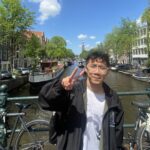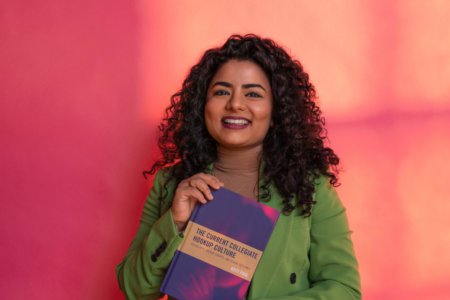
When we last spoke to Dr. Aditi Paul, she was the expert in online dating, having published a viral paper titled “Is Online Better Than Offline for Meeting Partners? Depends: Are You Looking to Marry or to Date?”
She was unique, sure, but hardly who you’d think of as a recipient of the EB-1, colloquially known as the “Einstein Visa.”
Educating other immigrants
Having gone through the PR process, Dr. Paul was well aware of a massive communication gap that exists between people who require immigration benefits and those providing immigration benefits.
That’s why she created Dr. Paul & Company, an education and mentorship-based network. The goal is to educate and train immigrants for the EB-1 pathway, a permanent residency (PR) green card reserved for foreign nationals who are either aliens of extraordinary ability, outstanding professors or researchers, or multinational managers or executives.
“I didn’t start it, to start it,” Dr. Paul says about the company. “I started creating content on LinkedIn in 2022, and I truly tried to be a research voice. But the person who was coaching me at the time said my immigration journey was exponentially more interesting than my research journey.”
As an Indian national, the trials and tribulations that she faced were harder than those of other nationalities. That’s because every country has a 7% cap per country. This per-country cap limits the number of family and employment-based immigration visas (green cards) allocated to nationals of any single nation. This means each country can receive no more than 7% of the total annual visas in the given categories.
“I had to wait for another 105 years. I would be dead and born again and then I would be a middle-aged person and I’d still be in line for a green card,” she says. “More than a green card, being on a temporary visa is unsustainable. It’s a very hard life.”
To Dr. Paul, it’s like asking someone to wear temporary contacts for life. It works, but it’s deeply uncomfortable. That pushed her to consider this so-called “Einstein” pathway, which she quickly learnt was often misunderstood.
“Have you heard how Americans describe spicy?” Dr. Paul asks. “Your spicy is not my spicy. Your extraordinary is not my extraordinary. I’ve been raised with a very different bar, because competition is high.”
Still, with a focus on online dating research, it seemed improbable to qualify for EB-1. Heck, she nearly lost her PhD scholarship. Could she really be deemed extraordinary?
But as she went on, she realised that it’s not about being extraordinary, per se, but different. There’s a hospital clown who is Russian, she says, that was allegedly given an EB-1 visa. How’s that for Einstein?
“No one told me that you can be different, and you can be one of a kind, and you have to show that with proof, and that’s enough,” she says. “That’s why I’m on a mission to help people, so that we do not become prisoners of our makings, thinking we’re not brilliant enough, so we have to wait in this line forever.”

Dr. Paul was originally from Kolkata. Source: Dr. Aditi Paul
Persecute one, terrify all
Nowadays, the journey has become even tougher. The announcement of the new US$100,000 H-1B fees was a shock to the community, making them more anxious than ever.
She quotes Doug Rand, who was previously Senior Advisor to the Director of USCIS, who said the US immigration’s motive is to “persecute some, terrify all.”
Plus, Dr. Paul believes that the “abuse of power is so multilayered.” Instead of dealing with US immigration directly, PR-seekers have to go through their employers. Even American employees are seen as disposable now, with massive layoffs nationwide. Immigrants, who are entirely reliant on their employers for their visa, are even more vulnerable.
“It’s adding layers and layers of insecurity to a person. Of course there is panic. It’s not just the panic of losing your job and hence your health insurance and everything else that comes with it, but also your legal status in the country. How unnerving is that?” Dr. Paul questions. “It kills a person psychologically before killing them in reality.”
Finding other pathways
The EB-1, however, is not a solution to the H-1B changes. You’d still need a temporary visa to protect your status while waiting for the green card, which would take some two to three years.
People have been considering the O-1 visa, which is also for individuals with extraordinary ability, but on a temporary basis.
In any case, Dr. Paul advises her clients to have open and honest conversations with their employers to make contingency plans. Ask questions like: Are you going to apply for my O-1 visa? Are you going to relocate me to Canada? Can I work in your office in India, and then come back on something called an L-1 visa? Am I just better off packing my bags?
For those who can afford it, it’s also extremely helpful to engage legal counsel, especially with those who “know their sh*t,” as Dr. Paul says. You might find some pro bono avenues as well.
“Employers’ lawyers are just that — employers’ lawyers,” she reminds. “I always encourage people to have their own, just like how you have your own accountants. There are things your employers’ lawyers say that are sometimes just made up.”

Dr. Paul regularly creates informative content on LinkedIn and other platforms. Source: Dr. Aditi Paul
It’s time to be creative
To international students who are hoping to stay in the country, but are faced with these monumental obstacles, Dr Paul advises: “Be creative.”
“This linear pathway might have worked for folks like us, but it’s not working for you,” she says.
She points towards the story of Ankur Nagpal, a serial entrepreneur. He also started with an F-1 visa as a student, then went the EB-1 route. When he was on his Optional Practical Training (OPT) period, though, he started Teachable and employed himself.
“These are unconventional measures that somebody has taken, not just sticking to the script,” Dr Paul says.
The American Dream is still alive
With how difficult the process of working and living in the US has become, it’s a wonder why there are still so many trying.
“The only way I can explain America is through a coconut,” Dr Paul says. “The external shield of a coconut is so tough, but the interior is mushy. It is sweet.”
The external layer, to Dr Paul, is the whole immigration process. But once you crack inside, she finds the US to still be an amazing place that rewards effort.
She points to the new CTO of AI company Anthropic, Rahul Patil, who was a student at PESIT in India, which is deemed as a “party school.” Patil’s role has been surprising to many, because he’s not from the Indian Institutes of Technology (IIT).
Coming from a Tier 3 college, but then immigrating to the US for university, and becoming the CTO of an AI company?
“This is why people come to America,” Dr Paul says. “It’s as close to a meritocracy as there is.”










